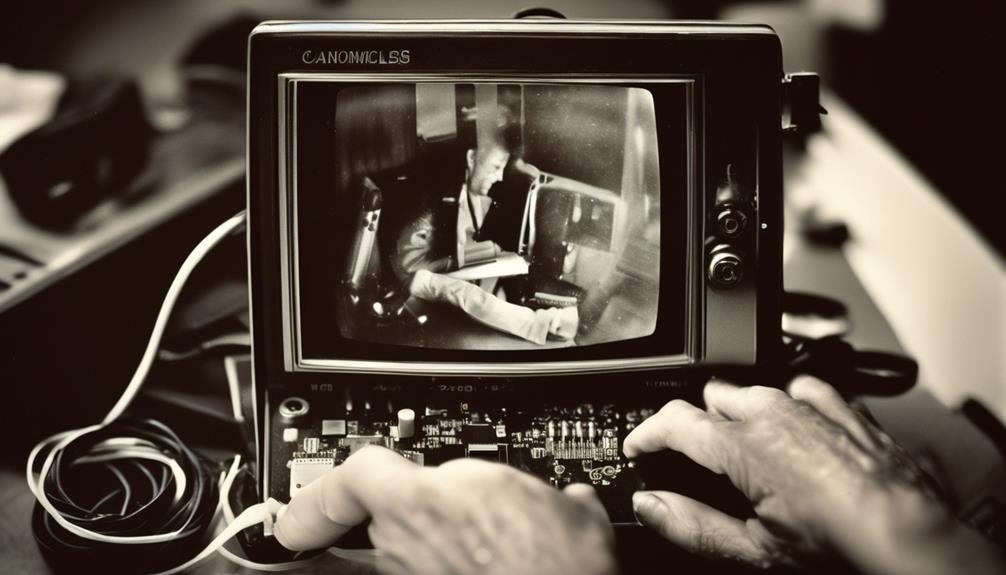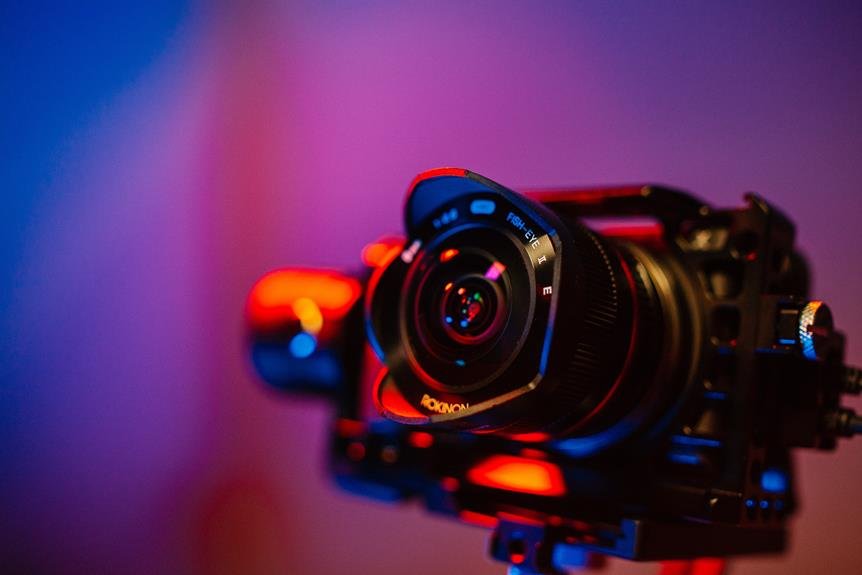We all know the frustration of having a perfectly good tool at our disposal, only to realize it's not performing as well as it could be. That's how I felt when I noticed my Canon mirrorless camera wasn't quite up to par. But fear not, because after diving into the world of firmware updates, I discovered 14 tips that made the process not only painless but also surprisingly rewarding. From checking for the latest firmware version to utilizing Canon's support resources, these tips not only ensure your camera is running at its best, but they also provide invaluable insights into maximizing its potential. So, if you're ready to unlock the full power of your Canon mirrorless, let's embark on this journey together.
Why Update Your Canon Mirrorless
Updating your Canon mirrorless camera can significantly enhance its performance and unlock new features, providing us with a more powerful and versatile tool for capturing stunning photographs and videos. There are several reasons for regular updates that we must understand to fully grasp the benefits. Firstly, updates often include improved autofocus performance, which is crucial for capturing sharp and clear images, especially in fast-paced or low-light situations. Additionally, updates can enhance the camera's overall speed and efficiency, reducing lag time and improving the overall shooting experience. Furthermore, firmware updates can introduce new shooting modes, creative filters, or advanced video capabilities, expanding the creative possibilities for our photography and videography. Moreover, updates often address any existing bugs or issues, ensuring that our camera operates smoothly and reliably. By staying current with updates, we can ensure that our Canon mirrorless camera is optimized for peak performance, allowing us to push the boundaries of our creativity and achieve outstanding results.
Check for Latest Firmware Version
After understanding the compelling reasons for regular updates, it's essential to proactively check for the latest firmware version for your Canon mirrorless camera to ensure optimal performance and access to new features.
When it comes to checking for the latest firmware version for your Canon mirrorless camera, here are some key steps to consider:
- Regularly Visit Canon's Official Website: Visit Canon's official website and navigate to the support section to check for the latest firmware updates specific to your camera model.
- Enable Camera Notifications: Some Canon mirrorless cameras allow you to enable notifications for firmware updates. Ensure this feature is turned on to receive alerts when new firmware is available.
- Utilize Canon's EOS Utility Software: Use Canon's EOS Utility software to connect your camera to your computer and check for firmware updates directly from the software interface.
- Subscribe to Canon's Newsletter: Subscribe to Canon's newsletter or follow their official social media channels to stay informed about the latest firmware updates and announcements.
- Consult Authorized Service Centers: If you encounter difficulties during the firmware update process, seek assistance from authorized Canon service centers for troubleshooting tips and guidance.
Keeping your Canon mirrorless camera's firmware up to date not only ensures optimal performance but also provides access to the latest features and enhancements, making it a crucial aspect of maximizing your photography experience.
Backup Your Data

To safeguard your valuable data and settings, it is imperative to create a comprehensive backup of your Canon mirrorless camera before proceeding with any firmware updates. Backing up files ensures that in the event of any unexpected issues during the update process, your data remains safe and accessible. Here's how you can ensure data protection and seamlessly update your Canon mirrorless camera.
First, connect your camera to a computer using a USB cable or insert the camera's memory card into the computer's card reader. Then, copy all the files from your camera to a designated folder on your computer. This includes both your photos and videos, as well as any custom settings or configurations you've established on your camera.
Additionally, consider using cloud storage services or external hard drives to create redundant backups for an added layer of security. Once your data is safely backed up, you can proceed with confidence, knowing that your valuable content and settings are protected. By following these simple steps, you can ensure that your data remains intact while enjoying the latest firmware updates for your Canon mirrorless camera.
Fully Charge Your Camera Battery
As we safeguard our valuable data and settings by creating a comprehensive backup before proceeding with any firmware updates, it is essential to ensure that our camera battery is fully charged to avoid any interruptions during the update process. Maximizing battery life and preventing data loss are crucial for a seamless update experience. Here are some actionable tips to fully charge your camera battery:
- Use the official charger: Ensure you use the manufacturer's recommended charger to optimize the charging process.
- Avoid partial charging: Fully deplete and then recharge your battery to maximize its capacity.
- Charge before the update: Always charge your battery to full capacity before initiating any firmware updates.
- Keep spare batteries charged: If possible, ensure you have spare fully charged batteries on hand for extended update processes.
- Utilize power-saving modes: Activate power-saving modes on your camera to conserve battery life during the update process.
Download the Firmware Update

Before proceeding with the firmware update, ensure that you have the latest version available by downloading it from the official Canon website or authorized sources. To assist you in this process, we have provided a step-by-step guide below, along with a troubleshooting section in case you encounter any errors or connection issues.
Downloading Firmware Update
- Step 1: Go to the official Canon website or authorized sources.
- Step 2: Search for your specific camera model in the support or download section.
- Step 3: Locate the latest firmware update for your camera and click on the download link.
- Step 4: Save the firmware file to your computer in a location where you can easily find it.
- Step 5: Follow the firmware update instructions provided by Canon to install the update on your camera.
Troubleshooting Errors
| Error | Solution |
|---|---|
| Firmware not recognizing camera | Ensure camera is connected properly |
| Update fails to install | Check for sufficient storage space on memory card |
Troubleshooting Connection Issues
| Issue | Solution |
|---|---|
| Camera not connecting to computer | Try using a different USB cable |
| Slow download speed | Use a stable internet connection |
Prepare the Memory Card
First things first, let's ensure that our memory card is fully compatible with the firmware update. Check the Canon website for a list of supported memory cards to avoid any issues. Next, we need to format the memory card in the camera to ensure it's clean and ready to receive the firmware update. This step is crucial for a smooth and successful update process.
Check Card Compatibility
To ensure seamless performance, it's crucial to confirm that the memory card you intend to use is compatible with your Canon mirrorless camera. Check camera settings and troubleshoot errors to guarantee optimal functionality. Here are some essential steps to check card compatibility:
- Consult the Camera Manual: Refer to the camera manual to identify the recommended memory card types and brands for your specific Canon mirrorless model.
- Visit the Manufacturer's Website: Check the official Canon website for a list of approved memory cards that are compatible with your camera.
- Check Card Speed Class: Ensure that the memory card's speed class meets the minimum requirements specified by your Canon mirrorless camera.
- Verify Capacity Limits: Some cameras have a maximum capacity limit for memory cards. Verify that the card's capacity does not exceed this limit.
- Test the Card: Before important shoots, test the compatibility of the memory card by capturing and reviewing a few test shots.
Ensuring proper card compatibility will help prevent errors and optimize the performance of your Canon mirrorless camera.
Format the Memory Card
We highly recommend formatting the memory card before commencing any significant shooting with your Canon mirrorless camera. Formatting tips ensure the memory card is optimized for your camera, reducing the risk of errors and maximizing performance. Insert the memory card into the camera and navigate to the format option in the camera's menu. Before proceeding, ensure all important data has been backed up as formatting will erase all existing content on the card. Once formatted, the memory card is prepared to handle the high-resolution images and videos produced by your Canon mirrorless camera. Proper memory card care includes regular formatting to maintain its efficiency. By following these formatting tips, you can ensure a seamless and reliable shooting experience with your Canon mirrorless camera.
Insert the Memory Card

Carefully insert the memory card into the designated slot until it clicks into place, ensuring a secure connection for your Canon mirrorless camera. This is a crucial step in maintaining the integrity of your camera's memory and ensuring smooth operation. Here's how to do it right:
- Check for Compatibility: Ensure that the memory card is compatible with your Canon mirrorless model. Refer to the camera's manual for recommended card types.
- Clean the Contacts: Before insertion, inspect the memory card for any dust or debris. Gently clean the contacts to ensure a proper connection.
- Insertion Angle: Align the memory card with the slot and insert it at the correct angle. Avoid applying excessive force, as this may damage the card or the camera.
- Secure Lock: Once inserted, ensure that the memory card's lock switch is not in the "lock" position, as this can prevent the camera from writing to the card.
- Troubleshooting: If the camera does not recognize the memory card, power off the camera, remove the card, and reinsert it. If issues persist, try using a different memory card to determine if the problem lies with the card or the camera.
Following these steps will help you insert and troubleshoot memory card issues for your Canon mirrorless camera efficiently.
Start the Firmware Update Process
Alright, now that we have our memory card inserted, it's time to kick off the firmware update process. First, we'll need to make sure we have the necessary firmware update files downloaded from the Canon website. Then, we can proceed with the actual update by following the step-by-step instructions provided by Canon.
Firmware Update Preparation
Before beginning the firmware update process for your Canon mirrorless camera, ensure that you have a fully charged battery and a stable internet connection to avoid any interruptions during the update. Here are some essential steps to prepare for a successful firmware update:
- Check Battery Level: Ensure your camera's battery is fully charged to prevent any power loss during the update.
- Stable Internet Connection: Connect your camera to a stable and reliable internet connection to avoid any issues with the firmware download.
- Backup Data: It's advisable to back up all your data from the camera to a computer or external storage to prevent any loss of important information.
- Disable Sleep Mode: Disable the sleep mode on your camera to prevent interruptions during the update process.
- Firmware Compatibility: Double-check that you are downloading the correct firmware version for your specific Canon mirrorless model.
Following these steps will help you prepare for a smooth and trouble-free firmware update process.
Firmware Update Execution
Now that you've prepared your Canon mirrorless camera for the firmware update, it's time to initiate the update process and ensure your device is equipped with the latest enhancements and features. Follow these steps to execute the firmware update seamlessly:
| Steps | Actions |
|---|---|
| 1. Backup | Before starting the update, ensure to back up all your important files and settings. This step is crucial to prevent data loss in case of any issues during the update process. |
| 2. Battery | Make sure your camera has sufficient battery power or connect it to a power source to avoid any interruptions during the update. Low battery can lead to failed updates. |
| 3. Connectivity | Use a stable and reliable internet connection to download the firmware update file. Unstable connections can cause interruptions leading to incomplete updates. |
Firmware updates bring benefits such as improved features and performance enhancements. However, common issues during updates can be avoided by following these troubleshooting tips.
Avoid Interrupting the Update

To ensure a successful update, it is essential to refrain from interrupting the process once it has begun. Interrupting the update can lead to firmware corruption, rendering the camera inoperable and requiring professional intervention to resolve. Here are some crucial tips to avoid interruptions during the update and troubleshoot any potential issues:
- Stable Power Supply: Ensure that your camera has a fully charged battery or is connected to a reliable power source. Any power disruption during the update can have severe consequences.
- Stable Internet Connection: If you are updating the firmware via Wi-Fi, ensure a stable and strong internet connection. A weak or intermittent connection can cause the update to fail, leading to potential issues with the camera's functionality.
- Backup Important Data: Before initiating the update, make sure to back up any important data stored on the camera. This precaution can mitigate the risk of data loss in case of an unexpected interruption.
- Patience: Once the update has begun, exercise patience and allow the process to complete without interruption. Even if it seems to be taking longer than expected, avoid the temptation to interrupt or power off the camera.
- Contact Support: If you encounter any issues or errors during the update, immediately reach out to Canon's support for guidance on troubleshooting and resolving the issues.
Verify the Update
Ensuring a successful update without interruptions is critical, and once the update process is completed, the next step is to verify that the update has been applied correctly. Verifying the update ensures that your Canon mirrorless camera is running the latest firmware, which can bring significant improvements in performance and new features. To verify the update, follow these simple steps:
| Verification Step | Action |
|---|---|
| Check the Firmware Version | Navigate to the camera's menu and locate the firmware version. Compare it to the latest version available on the Canon website. |
| Test New Features | Experiment with any new features or improvements that were included in the firmware update. This will help in understanding firmware benefits. |
| Troubleshooting Common Issues | If you encounter any issues, refer to the troubleshooting section in the updated firmware documentation. |
| Contact Support | If any problems persist after the update, contact Canon support for further assistance. |
Verifying the update not only ensures that the process was successful, but it also allows you to fully utilize any new enhancements. By understanding firmware benefits and troubleshooting common issues, you can make the most of your Canon mirrorless camera's capabilities.
Reset Camera Settings

Let's start by discussing the factory reset process, which can help resolve persistent issues or errors after an update. We'll also cover the importance of backing up custom settings before resetting the camera to avoid losing your preferred configurations. Understanding the potential impact on performance following a reset will also be a key point to consider.
Factory Reset Process
Before proceeding with the factory reset process, ensure that you have backed up any important files or settings from your Canon mirrorless camera to avoid permanent data loss. Factory resetting can help resolve persistent issues and ensure your camera functions optimally. Follow these steps for a successful factory reset:
- Charge your camera to avoid any interruptions during the reset process.
- Access the menu on your Canon mirrorless camera and navigate to the settings option.
- Look for the system or tools section within the settings menu.
- Locate the factory reset or reset all settings option and confirm the action.
- After the reset is complete, reconfigure your settings and test your camera to ensure the issues have been resolved.
Custom Settings Backup
After performing a factory reset on your Canon mirrorless camera, it is crucial to safeguard your custom settings by backing them up to ensure a smooth transition and avoid the need for reconfiguration in the future. To back up your custom settings, follow these steps:
| Step | Actions | Outcome |
|---|---|---|
| 1. Access menu | Navigate to the settings menu | Access the settings backup option |
| 2. Select backup settings | Choose the backup settings option | Save current settings to a specified location |
| 3. Confirm backup | Confirm the backup process | Ensure all settings are successfully saved |
| 4. Restore from backup | Navigate to settings menu | Select the restore option to retrieve backed-up settings |
| 5. Troubleshooting common issues | If settings are not restored, double-check the backup file | Ensure the backup file is not corrupted for successful restoration |
Impact on Performance
To maximize the performance of your Canon mirrorless camera, it's essential to understand the impact that resetting the camera settings can have and how it can contribute to enhancing your overall photography experience. Resetting the camera settings can significantly improve performance and enhance functionality in the following ways:
- Optimizing Speed: Resetting can help in clearing any unnecessary customizations that might be slowing down the camera's response time.
- Improving Battery Life: Resetting can optimize power management settings, potentially extending the battery life for prolonged shooting sessions.
- Enhancing Autofocus Accuracy: Resetting can recalibrate autofocus settings, leading to improved accuracy and sharpness in your photos.
- Restoring Default Image Quality Settings: This can help to ensure that your camera is set to deliver the best image quality possible.
- Solving Software Glitches: Resetting can resolve potential software issues that may be impacting the overall performance of your camera.
Resetting your camera settings can play a crucial role in maximizing its performance and enhancing overall functionality.
Update Canon's Software

We highly recommend updating your Canon mirrorless camera's software to ensure optimal performance and access to the latest features and improvements. Keeping your camera's software up to date is crucial for troubleshooting common issues and maximizing its potential. To update your Canon mirrorless camera's software, visit the official Canon website and navigate to the support section. Locate your specific camera model and check for available firmware updates. Download the latest firmware onto your computer and follow the provided instructions to install it on your camera. Firmware updates not only fix bugs and address performance issues but also provide customization options to enhance your shooting experience. These updates can introduce new features, improve autofocus performance, and enhance overall camera functionality.
Regularly updating your Canon mirrorless camera's software ensures that you are leveraging the full capabilities of your device. It's a simple yet effective way to stay ahead of any potential issues and take advantage of the latest advancements in technology. By staying proactive with software updates, you can ensure that your Canon mirrorless camera continues to meet your evolving photography needs.
Utilize Canon's Support Resources
When it comes to troubleshooting our Canon mirrorless cameras, it's important to make use of the resources available to us. Canon offers a support hotline that can provide immediate assistance with any technical issues we may encounter. Additionally, their online troubleshooting guides can be valuable tools for resolving common problems on our own.
Support Hotline Assistance
Canon's support hotline assistance and extensive support resources offer valuable assistance for updating your Canon mirrorless camera. Whether you encounter technical issues or simply need guidance, Canon's support team is dedicated to helping you get the most out of your mirrorless camera.
- Prompt Response: Canon's support hotline ensures quick access to assistance, minimizing any downtime.
- Expert Guidance: Knowledgeable support staff provide troubleshooting tips tailored to your specific mirrorless camera model.
- Remote Assistance: Utilize Canon's remote support options for real-time solutions to technical challenges.
- Online Resources: Access a wealth of online resources, including FAQs and user manuals, for self-help and guidance.
- Community Forums: Engage with other Canon users for peer-to-peer support and advice on updating your mirrorless camera firmware.
When updating your Canon mirrorless, rest assured that Canon's support hotline and resources are here to ensure a smooth and successful process.
Online Troubleshooting Guides
Utilizing Canon's extensive online troubleshooting guides and support resources is key to overcoming technical challenges and ensuring a seamless update process for your Canon mirrorless camera. When encountering issues during the update process, it's essential to have access to reliable troubleshooting tips and online resources for assistance. Canon provides comprehensive online support to address a wide range of technical issues, empowering users to resolve problems independently. Below is a table summarizing the online resources available on Canon's website to assist with troubleshooting and updating your mirrorless camera.
| Online Resources | Description |
|---|---|
| Troubleshooting Guides | Step-by-step instructions for common issues |
| Firmware Updates and Downloads | Latest firmware updates and software downloads |
| Community Forums | Engage with other users and seek advice |
| Live Chat Support | Instant assistance from Canon's support team |
These resources offer valuable assistance to ensure a smooth updating process.
Stay Informed for Future Updates

To ensure that we are always up to date with the latest advancements for our Canon mirrorless camera, it is crucial to actively seek out and stay informed about future updates. Staying updated on firmware alerts and update notifications is essential for maintaining our camera's optimal performance and accessing new features. Here are some actionable tips to help us stay informed for future updates:
- Subscribe to Official Channels: Keep an eye on Canon's official website, social media accounts, and newsletters for announcements regarding firmware updates and new features.
- Join Community Forums: Engage in online forums and communities where fellow Canon mirrorless users share information about the latest updates, potential issues, and workarounds.
- Follow Influential Photographers: Many professional photographers share insights and tips related to camera updates and maintenance. Following them on social media or subscribing to their blogs can provide valuable information.
- Set Up Alerts: Configure alerts on your devices for Canon firmware news and updates. This ensures that you don't miss any important announcements.
- Regularly Check Camera Menu: Periodically check the camera's menu for update notifications. This can help you stay on top of available updates and improvements.
Frequently Asked Questions
Can I Update My Canon Mirrorless Camera Using a Mac Computer?
Yes, you can update your Canon mirrorless camera using a Mac computer. The updating process is straightforward and Mac compatible. Simply connect your camera to the computer, download the latest firmware, and follow the on-screen instructions to complete the update.
Is It Possible to Rollback to a Previous Firmware Version if I Encounter Issues With the Latest Update?
Yes, you can rollback firmware on your Canon mirrorless camera if troubleshooting errors arise after the latest update. It's important to carefully follow the manufacturer's instructions to ensure a successful rollback process.
What Should I Do if My Camera Battery Dies During the Firmware Update Process?
When our camera battery dies during a firmware update, we panic! But don't worry, we can recover the firmware by connecting to a power source and following support options on Canon's website.
Are There Any Known Compatibility Issues With Third-Party Memory Cards When Updating the Firmware?
Memory card compatibility is crucial for a smooth firmware update. If errors occur, troubleshoot by using a different memory card from a reputable brand. This simple switch can often resolve issues and ensure a successful update process.
How Can I Troubleshoot Any Errors That Occur During the Firmware Update?
When troubleshooting errors during a firmware update, we recommend double-checking compatibility and taking precautions. If issues persist, consider a firmware rollback. Also, ensure Mac compatibility for seamless updates.



